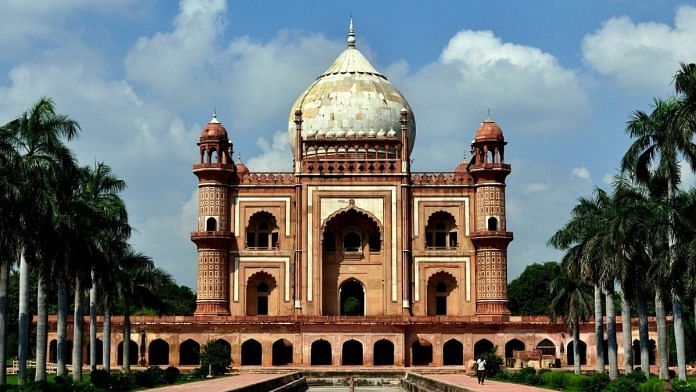New Delhi: The Safdarjung Tomb, one of Delhi’s most famous landmarks, located in the heart of the national capital, has suffered key damage and needs urgent care, pointed out a historian earlier this week.
Historian S Irfan Habib had posted a photo of the dome of the Safdarjung Tomb on social media. The Archeological Survey of India (ASI) has, however, denied his assertion, saying that it’s “weed-growth” triggered by the weather and incessant rains.
Speaking to ThePrint, an ASI spokesperson said: “Security concerns remain because the dome is high, but we are looking after it. We also faced a severe labour crunch because of Covid. Once the rain ends in the national capital, the clearing of weeds will be done. Conservation work is underway in all monuments across India through the year.”
The condition of the 18th-century monument, a mausoleum of the second nawab of Awadh, Mansoor Ali Khan Safdarjung, was highlighted by Habib’s tweet on his social media handle.
“This is Safdar Jung Tomb, an 18th-century monument in the heart of Delhi. Needs urgent attention of #ASI, the dome has developed cracks, with weed growing all over it. We just saw part of Begumpur mosque collapse,” he said, sharing a photo of the same.
This is Safdar Jung Tomb, an 18th century monument in the heart of Delhi. Needs urgent attention of #ASI , the dome has developed cracks, with weed growing all over it. We just saw part of Begumpur mosque collapse. Photo via @IamAdvRizvi @DalrympleWill pic.twitter.com/dopfGJleYZ
— S lrfan Habib (@irfhabib) September 18, 2021
“Covid has nothing to do with clearing of weeds, everything is happening in the city now. The entire central vista project is underway. The ASI’s explanation is very weak, this is negligence on their part. They are all ticketed monuments and attract a large number of footfalls. It’s ASI’s job to look after a monument that they are making money off it,” Habib told ThePrint.
The entire area of the complex is not well kept, “which was not the case a few years ago”, he added. “I don’t know if there is some selective negligence,” he said.
In July 2019, the Mughal-era monument became the third ASI-protected monument in Delhi — followed by Lal Qila and Purana Qila — in a “bid to restore and highlight (its) architectural beauty“. The Qutub Minar and Tughlaqabad Fort are next in line.
On September 13, historian William Darlymple shared a photo of the Begumpur mosque and the damage it had suffered due to the rain, blaming the ASI for neglecting the monument. “With better management, this vast medieval wonder could still be a major revenue-earning tourist site. Instead it’s being allowed to collapse & disappear,” he tweeted.
The roof of the Begumpur Masjid just collapsed in the rain due to ASI neglect. With better management, this vast medieval wonder could still be a major revenue-earning tourist site. Instead it's being allowed to collapse & disappear.@INTACHIndia@ASIDelhiCircle@ahluwaliadisha pic.twitter.com/3OVjnmx8ou
— William Dalrymple (@DalrympleWill) September 13, 2021
In this case, the ASI was quick to point out that the mosque’s roof collapse is not a recent event and had happened in the 1980s. On accusations against the body for neglecting the monument, the ASI said: “Several support pillars have been erected and buttress walls are also being built to neutralise the foundation settlement and prevent any collapse. Boundaries are being strengthened and water is being channelled away from the foundation. The debris that is strewn around is also being removed.”
However, Dalrymple had insisted that the damage was recent. “The ASI struggles to look after a large number of monuments with very limited budgets, and it is hardly their fault that they are not given the money they need to do their job properly. But when major monuments suffer major collapses, denying the problem cannot be the solution,” he said on Twitter.
The ASI struggles to look after a large number of monuments with very limited budgets, and it is hardly their fault that they are not given the money they need to do their job properly. But when major monuments suffer major collapses, denying the problem cannot be the solution.
— William Dalrymple (@DalrympleWill) September 14, 2021
“Some of our monuments are being neglected while others are being renovated when they should be restored,” Habib said to ThePrint, talking about the Jallianwala Bagh revamp.
(Edited by Paramita Ghosh)
Also read: Jallianwala Bagh victims’ memory deserves better. Disneyfication isn’t preservation



